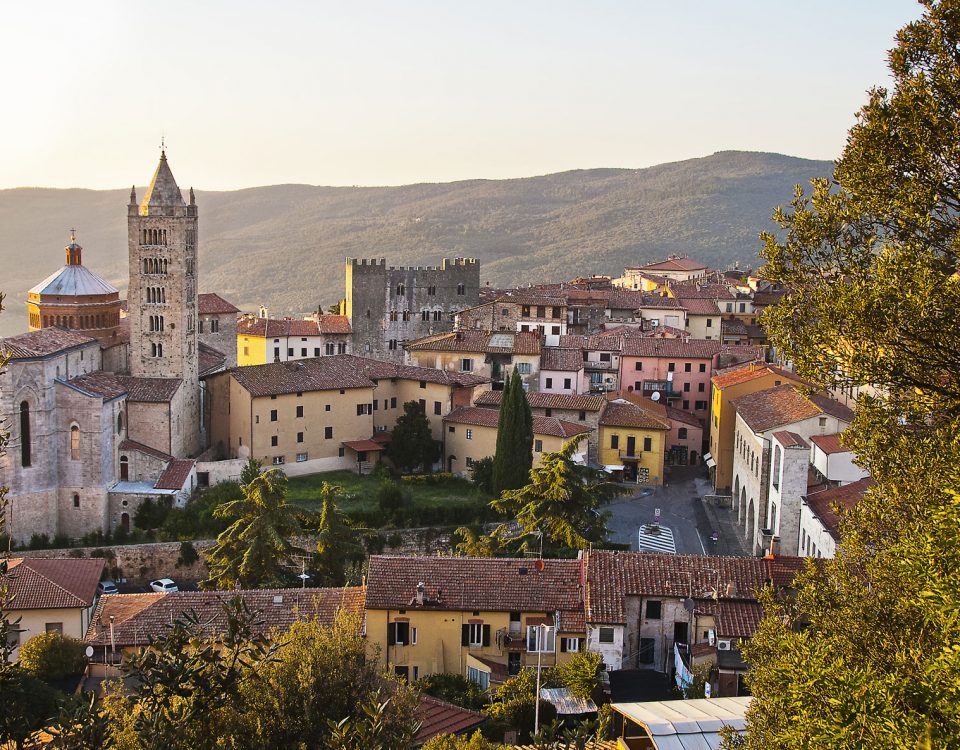OPENING HOURS
Daily : 8 am – 6 pm – Till 7 pm in the winter.
SUMMER OPENING HOURS (From 11 July til 31 August)
Daily 8 am – 7:30 pm
Special night openings Fridays and Saturdays
Daily from 8 a.m. to 7.30 p.m. (except in occosion of events in the square)
Holy Masse
Monday – Saturday 9 am
Sunday 11 am and 6 pm
Its construction started in the XI century and its structure has been changed throughout the centuries until it reached its final form at the beginning of the XIV century. For this reason some architectural elements have been removed over time and some of them are nowadays exposed in the Sacred Arts Museum. It is a great example of roman-gothic architecture and quite a good number of famous artists took part in its construction: Giovanni Pisano, Goro di Gregorio, Segno di Bonaventura, Giroldo da Como and Duccio di Boninsegna.
It is located on top of a huge and impressive stairway, dominating the whole Garibaldi Square from above. The façade is in pisan style, full of pillars, arches and statues by the famous sculpture Giovanni Pisano. Above its main portal there is an architrave with a bas-relief representing San Cerbone’s life, the bishop of Vetulonia and patron saint of Massa Marittima.
The apse has been extended since 1287 in gothic style with some romanesque elements, probably by the hand of Giovanni Pisano. The bell tower, in lombardy-romanesque style from the XII-XIII centuries, was widely restored and the upper part was almost completely rebuilt.
In the inside, the cathedral is organised in three aisles divided by travertine pillars, on top of them some capitels remind once again of Giovanni Pisano’s style. It is possible to admire many paintings and art masterpieces, like the marble Ark of San Cerbone, by Goro di Gregorio (1324), one of the highest examples of Italian gothic sculpture. Another noteworthy piece of art is the Baptismal Font in travertine by Giroldo da Como (1267), on top of which a marble tabernacle was placed in 1447. The Majesty by sienese Duccio di Buoninsegna (1316), the Crucifix by Segno di Bonaventura and the Crucifixion by Ambrogio Lorenzetti are all extraordinary work of art exposed on the walls.
A little trick…
As you can see, the Cathedral doesn’t face Piazza Garibaldi, but instead develops crosswise. Because of its unusual position the architect decided to resort to a perspective trick: he distributed the façade pillars at unequal distance from each other. This process creates an optical effect, so that if you look at the façade from the middle of the square, it will seem perfectly symmetrical.
Further information
Ivan Theimer’s altar in the Cathedral of Massa Marittima
In every sacred building, the altar is the centre and takes on a special significance in the overall view and in the celebration. The altar must be unique, because it is the symbol of Christ, and it must be made of stone, to remind us of Christ, the ‘Stone’ on which the Church is built. Ivan Theimer is an artist born in Moravia. In his early twenties, he left Czechoslovakia and moved to France where he completed his art studies. He currently lives in Paris, but is frequently in Italy, in Pietrasanta, where the artisans foundrymen and marble workers he works with are located.
These seven columns are adorned with various plant and animal elements: the vine, wheat, fish, from the biblical tradition; there are reproductions of the medieval codices that inscribe the celebration and reproduce liturgical books; there are animals linked to the tradition of Saint Cerbo (patron of the diocese to which the cathedral is dedicated) such as the goose, the bear, the deer; there are animals such as the tortoise and the snake that are taken from the patristic tradition that reinterprets the pagan tradition.
These two animals deserve a closer look because of their originality.
The turtle is an animal rich in symbolism, in China and India, precisely because of its shell, carapace, it was considered the embodiment of the ‘world’, the earth considered flat and the vault of heaven. The carapace, divided into 24 parts, offered divinatory elements to understand the course of the year’s harvests. The tortoise, taking refuge inside its shell, described the strength of the domestic virtues. Laying a large number of eggs signified fertility; living long indicated eternity: for this reason it was revered as a sacred animal and described as the support of the world whose foundations rested on its powerful shell.
Drawing on these ancient legends and rituals, Theimer has placed it in support of the columns supporting the altar: the snake between the legs of the taratruga is a clear allusion to many ancient beliefs of the animal’s immortality, changing its skin, reproducing the lost part. By depicting these two mythological animals, Theimer wanted not only to say that the Eucharistic Sacrifice is the expression of the new and eternal covenant, but also the overcoming of ancient sacrifices.
by Giovanni Santucci – Bishop




